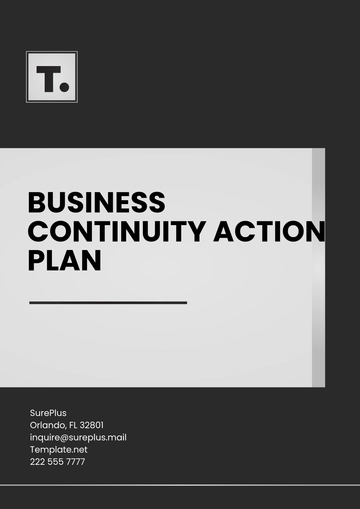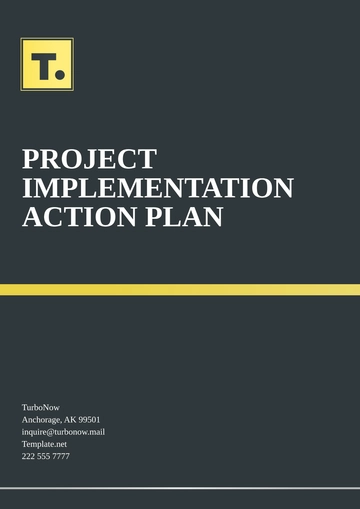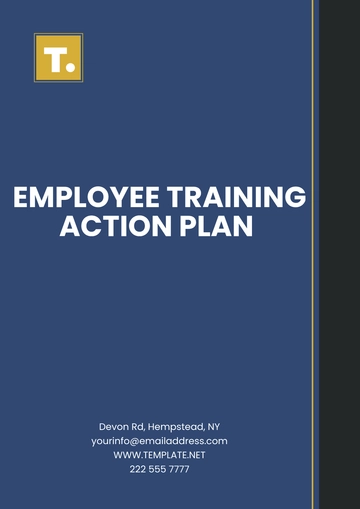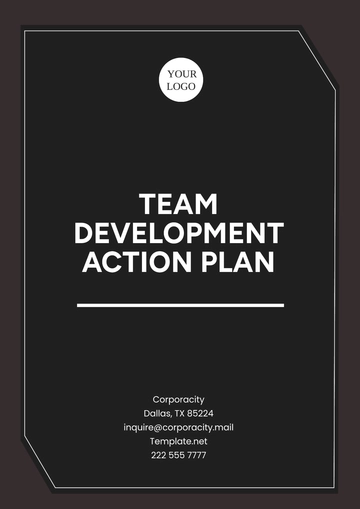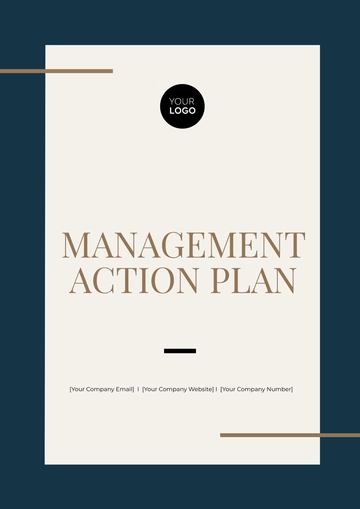Free Law Firm Action Plan
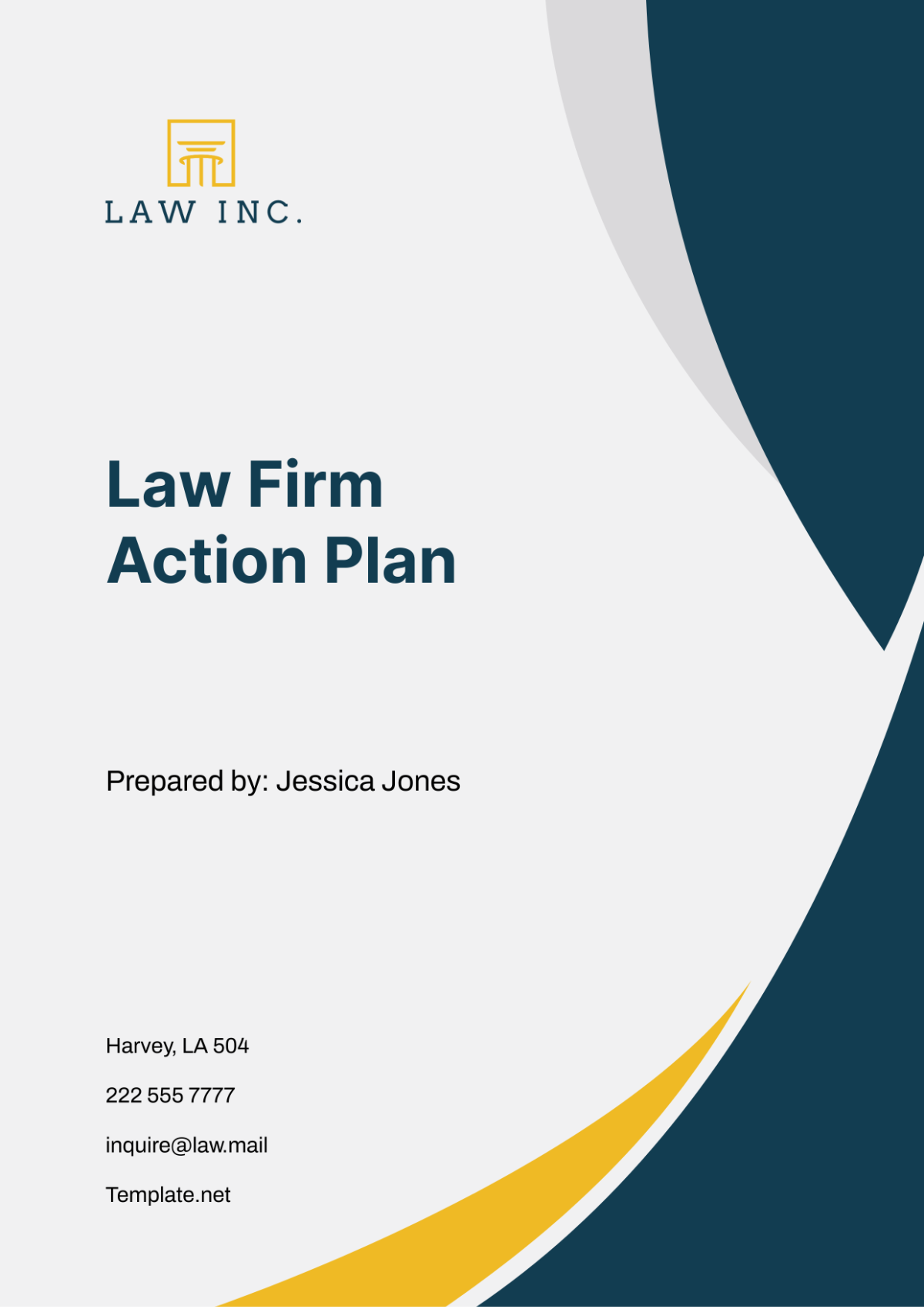
I. Executive Summary
[Your Company Name] is dedicated to providing exceptional legal services to our clients while fostering a culture of excellence and innovation within our firm. Our action plan outlines strategic initiatives aimed at driving growth, enhancing client satisfaction, and ensuring the long-term success of our practice.
Key objectives include expanding our client base, strengthening our brand presence, and optimizing internal operations to deliver superior value to our clients. By implementing the action plan outlined in this document, we aim to position [Your Company Name] as a leader in the legal industry while maintaining our commitment to integrity, professionalism, and client-centered service.
II. Vision and Mission Statements
Vision: To be recognized as the premier provider of legal solutions, trusted by clients for our expertise, integrity, and dedication to their success.
Mission: Our mission is to deliver innovative, strategic legal counsel tailored to the unique needs of each client, while fostering a culture of collaboration, excellence, and continuous improvement within our firm.
III. SWOT Analysis
The following SWOT (Strengths, Weaknesses, Opportunities, Threats) Analysis provides a concise overview of [Your Company Name]'s internal and external factors affecting its strategic position and performance.
Strengths | Weaknesses | Opportunities | Threats |
|---|---|---|---|
Highly skilled and experienced legal team | Limited brand awareness in certain market segments | Expansion into emerging practice areas | Competitive pressures from larger firms |
Strong reputation for delivering favorable outcomes | Dependency on a few key clients for significant revenue | Strategic partnerships with complementary service providers | Regulatory changes impacting the legal industry |
Established a network of referral partners and industry connections | Need for ongoing investment in technology and staff development | Leveraging digital marketing channels to reach new clients | Economic downturns affecting client demand |
Robust internal processes and systems for efficient case management | Diversification of revenue streams through innovative service offerings |
IV. Goals and Objectives
Expand Client Base:
Increase new client acquisition by 15% within the next fiscal year through targeted marketing campaigns and referral programs.
Cultivate relationships with potential clients in emerging industries and market segments.
Strengthen Brand Presence:
Enhance brand visibility through strategic partnerships, thought leadership initiatives, and participation in industry events.
Develop a comprehensive branding strategy to differentiate [Your Company Name] in the marketplace.
Optimize Operations:
Streamline internal processes and workflows to improve efficiency and maximize billable hours.
Invest in technology upgrades and training to enhance staff productivity and service delivery.
Enhance Client Satisfaction:
Implement client feedback mechanisms to measure satisfaction levels and identify areas for improvement.
Provide ongoing education and communication to clients to ensure transparency and alignment of expectations.
V. Target Market Analysis
[Your Company Name] serves a diverse client base, including individuals, small businesses, and corporate entities across various industries. Our target market segments include:
Small and Medium-sized Enterprises (SMEs)
Startups and Entrepreneurs
Healthcare and Life Sciences
Real Estate and Construction
Technology and Innovation
Financial Services
Non-profit Organizations
By understanding the unique needs and challenges of each target market segment, we can tailor our services and marketing efforts to effectively reach and engage prospective clients.
VI. Marketing and Branding Strategy
Digital Marketing:
Develop a robust online presence through a redesigned website, search engine optimization (SEO), and targeted digital advertising campaigns.
Leverage social media platforms to engage with clients, share thought leadership content, and showcase our expertise.
Thought Leadership:
Publish articles, blog posts, and whitepapers on relevant legal topics to position [Your Company Name] as a trusted authority in the industry.
Secure speaking engagements at industry conferences and events to showcase our expertise and network with potential clients.
Networking and Referral Partnerships:
Cultivate relationships with other professionals, including accountants, financial advisors, and consultants, to generate referrals and mutual business opportunities.
Host networking events and educational seminars to connect with potential clients and referral partners in our target market segments.
VII. Client Relationship Management
Client Onboarding:
Implement a streamlined onboarding process to welcome new clients and set clear expectations for the engagement.
Assign dedicated client relationship managers to serve as the primary point of contact and ensure timely communication and updates.
Ongoing Communication:
Provide regular updates to clients on the status of their matters, upcoming deadlines, and any relevant legal developments.
Solicit feedback from clients through surveys and reviews to assess satisfaction levels and identify opportunities for improvement.
VIII. Staff Training and Development
Continuing Education:
Invest in ongoing training and professional development opportunities for our legal team to stay abreast of industry trends, regulatory changes, and best practices.
Provide access to online courses, seminars, and certifications to enhance skills and expertise in specific practice areas.
Leadership Development:
Identify high-potential employees for leadership development programs aimed at grooming future firm leaders and managers.
Foster a culture of mentorship and knowledge sharing to facilitate the growth and development of junior staff members.
IX. Financial Projections and Budgeting
The following tables outline the financial projections and budgeting for [Your Company Name], including revenue forecasts and expense management strategies.
A. Revenue Forecast
Practice Area | Projected Revenue (Next Fiscal Year) |
|---|---|
Corporate Law | $500,000 |
Litigation | $400,000 |
Real Estate | $300,000 |
Intellectual Property | $250,000 |
Employment Law | $350,000 |
Other Practice Areas | $200,000 |
Total | $2,000,000 |
The Revenue Forecast table delineates projected revenue figures across various practice areas, offering insights into the firm's revenue-generating potential and identifying areas of strength or opportunity. It indicates that Corporate Law and Litigation are expected to contribute the highest revenue, suggesting that these practice areas are key drivers of the firm's financial performance. Meanwhile, the allocation of revenue across different practice areas enables the firm to assess the diversification of its revenue streams and identify areas for growth or expansion.
B. Expense Management
Expense Category | Projected Expense (Next Fiscal Year) |
|---|---|
Personnel Costs | $800,000 |
Office Rent and Utilities | $150,000 |
Marketing and Advertising | $100,000 |
Technology and Software | $120,000 |
Professional Development | $50,000 |
Legal Research and Subscriptions | $30,000 |
Other Operating Expenses | $100,000 |
Total | $1,350,000 |
The Expense Management table outlines the firm's anticipated expenses across different categories, providing transparency into the allocation of financial resources and highlighting areas of investment or cost containment. It shows significant expenditure on Personnel Costs, indicating the firm's commitment to investing in its human capital to deliver high-quality legal services. Additionally, the allocation of expenses towards Marketing and Advertising underscores the firm's strategic focus on brand building and client acquisition.
X. Implementation Timeline
The table below outlines specific action steps, responsible parties, timelines for implementation, and current status updates for each task within the Implementation Timeline of [Your Company Name]'s action plan.
Action Step | Responsible Party | Timeline | Status |
|---|---|---|---|
Conduct staff training needs assessment | HR Manager | Month 1 | In Progress |
Develop training curriculum and materials | Training Committee | Months 2-3 | Pending |
Implement new case management software | IT Department | Months 4-6 | Not Started |
Launch redesigned website | Marketing Department | Month 7 | In Progress |
Initiate digital marketing campaigns | Marketing Department | Months 8-10 | Pending |
Host networking events and seminars | Business Development Team | Months 11-12 | Not Started |
Monitor and evaluate progress against KPIs | Management Team | Ongoing | Ongoing |
XI. Monitoring and Evaluation
Key Performance Indicators (KPIs):
Define measurable KPIs to track progress toward achieving goals and objectives outlined in the action plan.
Regularly review KPIs to assess performance, identify areas of improvement, and make data-driven decisions.
Performance Reviews:
Conduct regular performance reviews with staff members to provide feedback, address any performance issues, and align individual goals with firm objectives.
Solicit input from clients through satisfaction surveys and reviews to gauge the effectiveness of our service delivery and identify opportunities for improvement.
XII. Risk Management
Risk Identification:
Conduct a comprehensive risk assessment to identify potential threats to the successful implementation of the action plan.
Prioritize risks based on severity and likelihood of occurrence to focus mitigation efforts on the most critical areas.
Risk Mitigation:
Develop risk mitigation strategies and contingency plans to address identified risks and minimize their impact on firm operations.
Monitor key risk indicators and implement proactive measures to mitigate emerging risks in a timely manner.
By proactively addressing risks and challenges, [Your Company Name] can minimize disruptions to its operations and ensure the successful execution of its action plan.
XIII. Conclusion
The [Your Company Name] Action Plan provides a strategic roadmap for achieving our firm's objectives and positioning ourselves for long-term success in the competitive legal landscape. By focusing on client satisfaction, brand building, operational excellence, and continuous improvement, we are confident that we can achieve our goals and deliver exceptional value to our clients. Through diligent implementation and ongoing monitoring, we will adapt to evolving market dynamics and seize new opportunities for growth and innovation.
- 100% Customizable, free editor
- Access 1 Million+ Templates, photo’s & graphics
- Download or share as a template
- Click and replace photos, graphics, text, backgrounds
- Resize, crop, AI write & more
- Access advanced editor
Drive strategic initiatives with Template.net's Law Firm Action Plan Template. Editable in our AI Editor Tool, this customizable template provides a structured format for outlining goals, strategies, action steps, and timelines to achieve desired outcomes in your law firm. Enhance productivity, foster accountability, and track progress effortlessly with ease and convenience!



